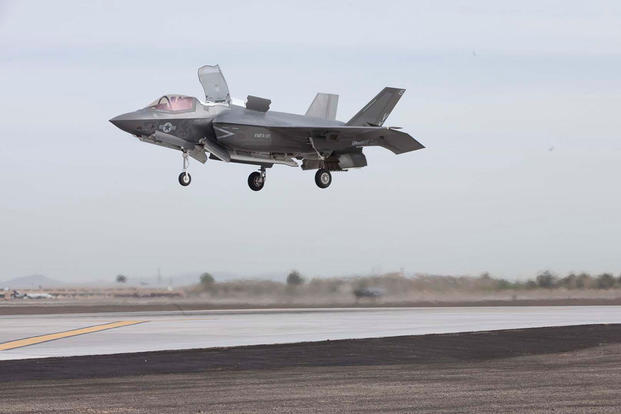The U.S. Marine Corps is expected to announce the F-35 Joint Strike Fighter is ready to fly initial operations in the near future, a general said.
During a conference call with reporters on Monday afternoon, Lt. Gen. Jon Davis, the service's deputy commandant for aviation, said the F-35B jump-jet version of the Lockheed Martin Corp.-made plane may "soon" reach the milestone, known as initial operational capability in military parlance.
"I would say soon, but … I'm not going to rush Gen. Dunford," Davis said, referring to Commandant Gen. Joseph Dunford, in response to a reporter who asked when a decision might be made. "Bottom line, he and I talked and he's a busy guy and he's working his way through that right now. But I'll tell you, we met all of our IOC criteria."
The F-35 is the Pentagon's most expensive weapons acquisition program, estimated to cost $391 billion to purchase 2,457 aircraft for the Air Force, Marine Corps and Navy. The Corps plans to begin operational flights this year -- albeit with a less lethal version of the aircraft -- followed by the Air Force in 2016 and the Navy in 2019.
'IMPRESSIVE' KILL RATES
The Corps plans to buy a total of 420 of the fifth-generation stealth fighters, including 353 F-35Bs, the short-takeoff-and-vertical-landing (STOVL) versions that fly like a plane and land like a helicopter, and 67 F-35C variants designed for use aboard aircraft carriers, the general said.
Related Video
During a recent operational readiness inspection, the aircraft -- armed with the GPS-guided Joint Direct Attack Munition and laser-guided GBU-12 Paveway II bombs -- performed well in such missions as armed reconnaissance, interdiction, opposed strike and close air support, Davis said.
"The exchange rates and the kill rates that we had against the adversary aircraft in a multi-mission profile was very, very impressive," he said. "They did very, very well -- great accuracy with the hits."
Indeed, Davis said he was surprised how the planes were able to execute a high-threat scenario for the armed reconnaissance sortie.
"We would never put a legacy platform -- an F/A-18 or a Harrier -- in that kind of threat environment, but these guys went and did it," he said.
For example, during the U.S.-led attack against Iraq in 1989, "going after those Scuds [ballistic missiles] in Desert Storm -- that was a high-profile target that we had to address first for strategic regions and if they had been defended by some high-end SAMs [surface-to-air missiles], it would have been probably prohibitive for us to go after them like we did," he said. "Now, you've got a radar and a sensor that would basically allow you to find those things a heck of a lot better and do that in a high-threat environment."
'MAKE DO'
Even so, Davis acknowledged that Marines will have to "make do" with a less lethal version of the airplane. For example, the early operational F-35Bs won't include a new night-vision helmet, Small Diameter Bomb II or GAU-22/A four-barrel 25mm Gatling gun -- or the ability to stream video or simultaneously fuse sensor data from four aircraft.
"I'd like to have full four-ship fusion, but I'll make do with a two-plus-two," he said, referring to a workaround in which sensor data from two aircraft are shared with another pair of aircraft via a Link 16 tactical data connection.
Davis said the workaround performed well in operational scenarios and that existing fourth-generation planes in the fleet don't have any so-called sensor fusion. He also said pilots convinced him that they could track targets at night using improved panels on the cockpit screen.
"I would have liked to have had the full four-ship fusion and the NVG full compatibility of the helmet, but I'll wait on that," he said. Many of the weapons improvements will be included as part of a future software upgrade, known as 3F, which is slated for fully operational F-35Bs in late 2017.
READY FOR DOGFIGHTS
Davis also defended the aircraft from criticisms that it can't outperform an F-16 in a dogfight or A-10 in providing close air support to ground troops. "I love the F-16, I think it's a great airplane," he said. But in a dogfight, he'd rather be in a new Joint Strike Fighter than a legacy Fighting Falcon, he added.
While the exchange rates from the operational readiness inspection are classified, he said, "We put a four-ship up against nine bad guys. It didn't go so well for the bad guys. It went poorly for the bad guys, all of them."
Davis acknowledged the F-35B isn't slated to receive its cannon until 2017. But he said the plane was able to perform close air support missions using the GPS and laser-guided bombs. "We used the kind of profiles we're using out there in Syria and they did very, very well," he said. "And unlike in Syria, we actually had some high-threat conditions out there, as well, where they did the close air support, did it very effectively in a medium- and a high-threat scenario.
"I am very confident that I could send them pretty much to pretty much anyplace in the world to employ this weapon systems in a close air support environment," he added. "My Marines would get the support on the ground from this airplane and I don't need a big support package to go in and clear the airspace for them. They'll be able to go in as a two-ship or a four-ship and be able to do the CAS we need to do without a big support package -- that is unprecedented."
--Brendan McGarry can be reached at brendan.mcgarry@military.com




























